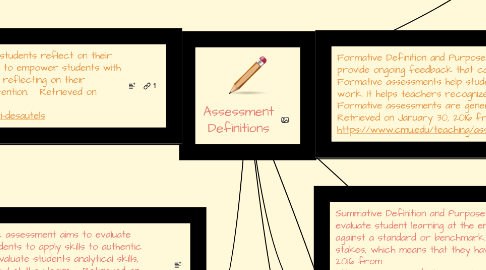
1. High-Stakes Definition and Purpose: Testing used to measure student, teacher, school district and state performance. Usually in the form of an exam and multiple choice. Also used as a way to hold teachers and schools accountable since NCLB.
1.1. Advantages: Measurable specific data :
1.1.1. Disadvantages: One size fits all testing. Leads to teaching to the test vs a more creative and flexible curriculum.
1.2. For learning: Provides teachers and administrators with measurable data on student progress.
1.3. Example: PARCC, SAT
2. Portfolio Definition and Purpose: A form of authentic assessment, its a collection of student work. The purpose of portfolios is to document and demonstrate student effort and accomplishments. A portfolio usually includes a set of goals. student collaboration in choosing work that goes into the portfolio, self reflection and assessment. Retrieved on January 30, 2016 from http://www.education.com/reference/article/portfolio-assessment/
2.1. Advantages: Provides organized documentation of student work which the student and teacher can look back on.
2.1.1. Disadvantages: Students may not be intrinsically motivated to participate. Its time consuming.
2.2. For and Of Learning: Student is able to self-reflect and partake in the assessment process. Teacher has access to a very rounded and specific representation of individual students.
2.3. Example: A folder showcasing student work during a unit, semester or the school year. It can include art work, drafts, written work, self reflection or anything representative of the students effort and academic abilities.
3. Authentic Assessment Definition and Purpose: Authentic assessment aims to evaluate students' abilities in 'real-world' contexts. It teaches students to apply skills to authentic projects. The purpose of authentic assessment is to evaluate students analytical skills, creativity, ability to work collaboratively and integrate what they learn. Retrieved on January 30, 2016 from https://www.teachervision.com/teaching-methods-and-management/educational-testing/4911.html
3.1. Advantages: Students use higher order thinking skills. Students learning is correlated with real life skills.
3.1.1. Disadvantages: Students or teachers may have limited or lack of access to resources needed to implement authentic assessments. It requires more time and investment.
3.2. For Learning: Centered on student learning and self-reflection.
3.3. Example: A PBL activity would be considered an authentic assessment. Working with the Smithsonian on a project to translate museum pamphlets into Spanish.
4. Self Assessment Definition and Purpose: A learning tool in which students reflect on their own work. The purpose of teaching students self assessment is to empower students with the tools necessary to learn how to be an effective learner by reflecting on their learning process and improving their ability to engage and pay attention. Retrieved on January 30, 2016 from http://www.edutopia.org/blog/self-assessment-inspires-learning-lori-desautels
4.1. Advantages/Disadvantages: Students learn skills that will lead them to become intrinsically motivated.
4.1.1. Of Learning
4.2. Of and For Learning: Students learn to self assess and reflect on their learning. Teachers can learn about the students study habits and organizational skills.
4.2.1. An example of self assessment in an elementary classroom may be providing students with a list of daily goals that they can accomplish in order to become better learners. Students can use the list to check their progress and what they accomplished for the day and what they could improve upon. Elementary students have not perfected the art of self-reflection and need guidance to develop this skill.
5. Peer Assessment Definition and Purpose: Students take part in evaluating each others work it deepens students’ understanding of their own learning and empowers them to become more actively engaged and self-directed in their learning. Retrieved on January 30, 2016 from https://learningsciences.utexas.edu/teaching/assess-learning/feedback/peer-assessment
5.1. Advantages/Disadvantages: Advantages: Empowers students to take part in the learning process and allows for positive interaction and collaboration. Disadvantages: There is concern that friendship will lead to evaluation bias or students will be mean or bully certain students. Others feel it is solely the instructors responsibility or it will take to much time away from student learning.
5.1.1. Of Learning
5.2. Of Learning: Students learn through the process of assessing others work and having their own work evaluated.
5.3. Example: Pair students to look over and provide feedback for a project before submitting the final product. At an elementary level teachers should model what questions to ask and how to provide specific feedback.
6. Formative Definition and Purpose: The goal of formative assessment is to monitor student learning to provide ongoing feedback that can be used by teachers to improve their instruction and student learning. Formative assessments help students identify their strengths and weaknesses and target areas that need work. It helps teachers recognize where students are struggling and address problems immediately Formative assessments are generally low stakes, which means that they have low or no point value Retrieved on January 30, 2016 from https://www.cmu.edu/teaching/assessment/basics/formative-summative.html
6.1. Advantages: Teacher can regularly check in on student learning and grasp of information and adjust planning and lessons accordingly. Helps plan for scaffolding. Highly effective in raising student achievement.
6.1.1. Disadvantages: Some formative assessments may leave room for students to confirm that they grasp a concept when that may not necessarily be the case. Example: Thumbs up/down students may give thumbs up because all other do.
6.2. For Learning: Teacher can progressively check on student understanding and grasp of information and topics covered.
6.3. Example: Thumbs up/down, exit tickets, Traffic light having students put up red, yellow or green signs to signal understanding.
7. Summative Definition and Purpose: The goal of summative assessment is to evaluate student learning at the end of an instructional unit by comparing it against a standard or benchmark. Summative assessments are often high stakes, which means that they have a high point value. Retrieved on January 30, 2016 from https://www.cmu.edu/teaching/assessment/basics/formative-summative.html
7.1. Advantage: Measurable cumulative results. Summative can always become formative if student has not grasped concept or lesson. :
7.1.1. Disadvantages: Different factors may influence performance during a summative assessment and it may not necessarily be indicative of true student performance.
